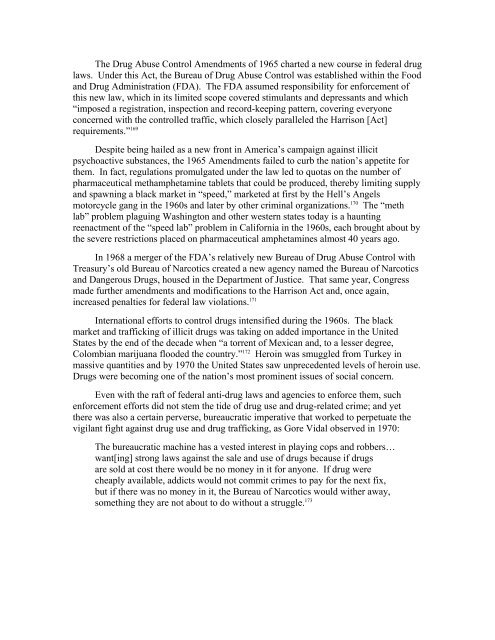Effective Drug Control: Toward A New Legal Framework
Effective Drug Control: Toward A New Legal Framework
Effective Drug Control: Toward A New Legal Framework
Create successful ePaper yourself
Turn your PDF publications into a flip-book with our unique Google optimized e-Paper software.
The <strong>Drug</strong> Abuse <strong>Control</strong> Amendments of 1965 charted a new course in federal drug<br />
laws. Under this Act, the Bureau of <strong>Drug</strong> Abuse <strong>Control</strong> was established within the Food<br />
and <strong>Drug</strong> Administration (FDA). The FDA assumed responsibility for enforcement of<br />
this new law, which in its limited scope covered stimulants and depressants and which<br />
“imposed a registration, inspection and record-keeping pattern, covering everyone<br />
concerned with the controlled traffic, which closely paralleled the Harrison [Act]<br />
requirements.” 169<br />
Despite being hailed as a new front in America’s campaign against illicit<br />
psychoactive substances, the 1965 Amendments failed to curb the nation’s appetite for<br />
them. In fact, regulations promulgated under the law led to quotas on the number of<br />
pharmaceutical methamphetamine tablets that could be produced, thereby limiting supply<br />
and spawning a black market in “speed,” marketed at first by the Hell’s Angels<br />
motorcycle gang in the 1960s and later by other criminal organizations. 170 The “meth<br />
lab” problem plaguing Washington and other western states today is a haunting<br />
reenactment of the “speed lab” problem in California in the 1960s, each brought about by<br />
the severe restrictions placed on pharmaceutical amphetamines almost 40 years ago.<br />
In 1968 a merger of the FDA’s relatively new Bureau of <strong>Drug</strong> Abuse <strong>Control</strong> with<br />
Treasury’s old Bureau of Narcotics created a new agency named the Bureau of Narcotics<br />
and Dangerous <strong>Drug</strong>s, housed in the Department of Justice. That same year, Congress<br />
made further amendments and modifications to the Harrison Act and, once again,<br />
increased penalties for federal law violations. 171<br />
International efforts to control drugs intensified during the 1960s. The black<br />
market and trafficking of illicit drugs was taking on added importance in the United<br />
States by the end of the decade when “a torrent of Mexican and, to a lesser degree,<br />
Colombian marijuana flooded the country.” 172 Heroin was smuggled from Turkey in<br />
massive quantities and by 1970 the United States saw unprecedented levels of heroin use.<br />
<strong>Drug</strong>s were becoming one of the nation’s most prominent issues of social concern.<br />
Even with the raft of federal anti-drug laws and agencies to enforce them, such<br />
enforcement efforts did not stem the tide of drug use and drug-related crime; and yet<br />
there was also a certain perverse, bureaucratic imperative that worked to perpetuate the<br />
vigilant fight against drug use and drug trafficking, as Gore Vidal observed in 1970:<br />
The bureaucratic machine has a vested interest in playing cops and robbers…<br />
want[ing] strong laws against the sale and use of drugs because if drugs<br />
are sold at cost there would be no money in it for anyone. If drug were<br />
cheaply available, addicts would not commit crimes to pay for the next fix,<br />
but if there was no money in it, the Bureau of Narcotics would wither away,<br />
something they are not about to do without a struggle. 173
















